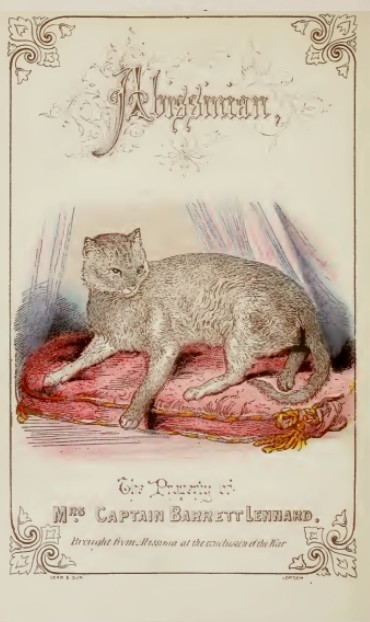
THE ABYSSINIAN CAT – AN EARLY HISTORY
This page is in roughly chronological order of import events in the early history of the breed pulled together from old books and newspapers.
There are many fanciful claims about the origin of the Abyssinian breed. It is considered to be the breed closest in appearance to the original domesticated cat (based upon ancient Egyptian depictions) and the original cats used to develop the Abyssinian are believed to have been imported into England from the Middle East in the mid-1800s. The modern Abyssinian is very much a man-made breed, because the imported cats were extensively bred with British domestic cats, including British Ticks (random-bred ticked tabby shorthairs). Cat fanciers had their own idea of the desired look and the cats were crossed to Russian Blues and Siamese to alter the conformation, and even to Persians and Angora, which had the side effect of introducing the recessive longhair gene. Selective breeding reduced the unwanted striping on the neck, legs, tail and face and increased the ear size. From this mix of imports and breeds, fanciers refined the type into the modern Abyssinian.
It is more likely that the original cats had been taken to Abyssinia as the pets of Army Officers and their wives who had previously been stationed in India or Ceylon (Sri Lanka). Sandy-coloured ticked cats were known as Indian cats in the early days of the cat fancy and are now represented by the rare "Celonese" breed. Their arrival in Britain coincided with the end of the Abyssinian war, but it’s the Abyssinian name that stuck, not the Indian name. Modern DNA analysis places the origin of the breed in Asia rather than Africa. This ties in with the alternative name for sandy-coloured ticked cats “Indian Cat” and the Leiden Zoological Museum (Netherlands) having an taxidermy exhibit of an Abyssinian purchased in 1834-1836 which is labelled "Patrie, domestica India".
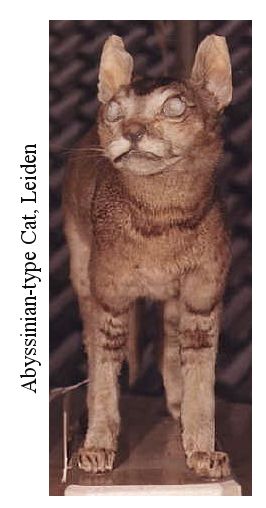

1834-1836 - Leiden Zoological Museum (Netherlands) acquire a taxidermy of an “Indian Cat.” This ticked cat pre-dates the more famous “Zula” by 30 years.
1867 - Abyssinian cats (in general) were mentioned by C H Ross in his "Book of Cats" "In Abyssinia cats are so valuable that a marriageable girl who is likely to come in for a cat is looked upon as quite an heiress." In fact Abyssinia (modern day Ethiopia), had no tradition of domestic cats and later explorers in the region found no domestic cats of any type.
1868 - Most histories tell you that the first Abyssinian cat was “Zula,” brought to England by a British soldier in 1868, returning from the Abyssinian War (Ethiopia today). Drawings of Zula depict a cat very different from Abyssinians exhibited at early cat shows. The drawing suggests longer fur than modern Abyssinians.

1871 – The first Abyssinian to be exhibited was Zula, who made an appearance at the December 1871 Crystal Palace Show of December 16th, 1871. A description of Zula was included in the illustrated article published in Harper's Weekly, 27th January, 1872: "The first prize was won by a Persian she cat of rare violet colour, whose portrait is given on this page. The third prize was taken by the Abyssinian cat, shown in the lower right hand corner of the illustration. She was captured in the late Abyssinian war, and was mostly remarkable for her woebegone appearance, seemingly discontented at her sudden elevation into notoriety, and longing for her barbaric freedom in the good old days of King Theodore." In the illustration she appears to be partly hidden under a blanket.
1874 - The first real mention of Abyssinian cats appeared to be in the book "Cats, Their Points, Etc" by Gordon Stables. The book contained a colour print of 'Zula, the property of Mrs. Captain Barrett-Lennard' and stated that the cat was “brought from Abyssinia at the conclusion of the war, fed on the way home on raw beef and was long very wild. She is now very fond of her mistress, but has a great many eccentricities which other cats have not, and is altogether a wonderful specimen of cat-kind."
1882 – The Abyssinian was listed as a separate breed in 1882, but in 1889, Harrison Weir ("Our Cats and All About Them") insisted that it was not a breed at all. Louis Wain agreed with him. Both of those notable early cat fanciers and judges considered that "very passable Abyssinian-type kittens are born from time to time as the result of 'chance matings' between very ordinary tabbies." Weir found the native British Ticks to be scarcely distinguished from the imported Abyssinian and some of the early Abyssinian champions were very evidently Ticked British Shorthairs. The first mention of Silver Abyssinians also came from Weir in 1882. He referred to them as a new variety.
1887 - About the year 1887, a red kitten appeared in a litter born to one of the first pairs of Abyssinians imported into Britain. He was bred by Sir Joshua (or John) Dunze – but the apricot-coloured kitten and its usual-coloured brother were given away as pets to a little girl. This is the first recorded Red Abyssinian.
1889 - Harrison Weir creates the first Standard of Points for Abyssinians. In "Our Cats and All About Them" (1889), Harrison Weir mentioned a cross between the English wild cat and a domestic cat that resulted in ticked kittens similar to the imported “Abyssinian” cat (i.e. the cats purported to be from that region). "Still several have been imported from Abyssinia all of which were precisely similar, and it is stated that this is the origin of the Egyptian cat that was worshipped so many centuries ago. […] The imported cats are of stouter build than the English and less marked. These bred with an English tabby often give a result of a nearly black, the black band extending very much down the sides, and the brown ticks almost disappearing, which gives a very rich and beautiful colouring." Weir described both the ruddy (usual) Abyssinian and also mentioned the existence of a silver-grey variety.
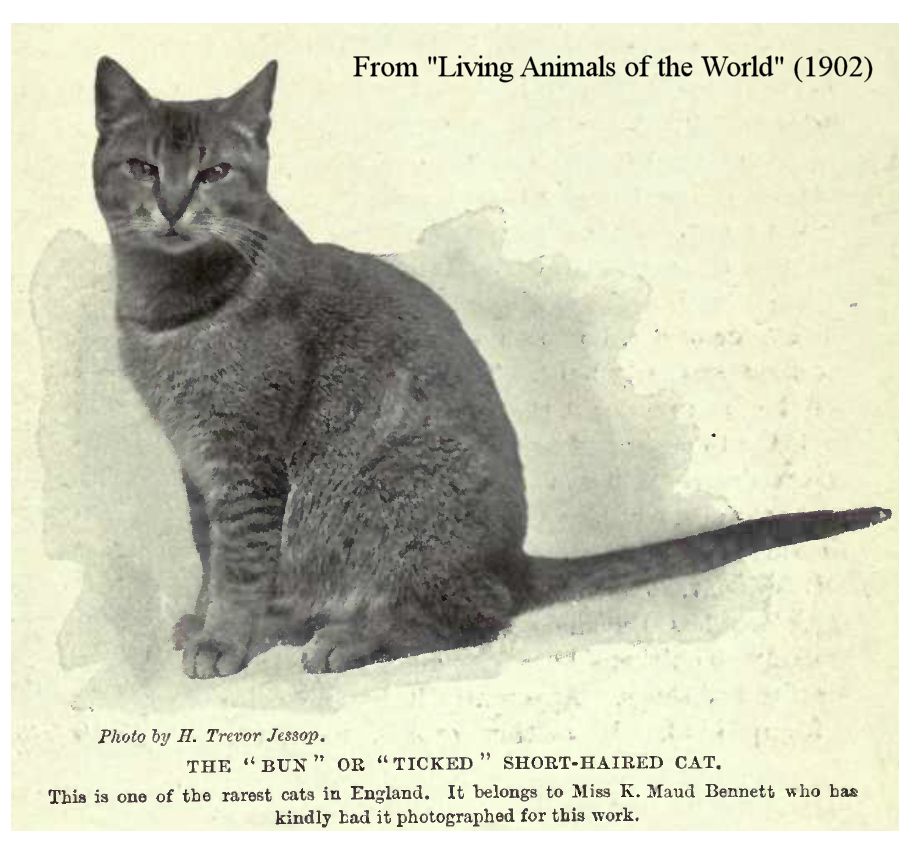
Weir's breed standard called for a larger cat than we see today. Without their own class at shows, they competed in the "Any Other Variety Foreign Cat" class against wild cats, Indian cats and Japanese cats. Abyssinian breeders considered this situation unfair because the domesticated Abyssinian frequently lost out to novelties and exotic wildcats. Ticked cats were bred in England from ordinary tabbies and were almost indistinguishable from the Abyssinian except for being less heavily marked and less stout than the imported cats. This sounds the wrong way round, but in Weir’s time English shorthairs were far less cobby than modern British Shorthairs while the Abyssinian had not yet been “refined”.
Rather than being seen as a breed in its own right, the Abyssinian was initially considered "most useful" for crossing with other breeds to produce a variety of ticked colours. Experimental matings were done to find out what "delightful grizzled hues" would turn up in the offspring. One result was the Abyssinian Chinchilla, an early form of Silver Abyssinian. It seemed natural for breeders to cross them with Chinchilla Persians to improve the chinchilla’s silver ticked coat
1890-ish Queen Jumbo (silver Abyssinian) born. This was the first registered Abyssinian (NCC 1561).
1892 Sedgemere Bottle born.
1894 Sedgemere Peaty born.
It is also often written that the first Abys recorded in the National Cat Club Stud Book were Sedgemere Bottle (NCC 2314, male) and Sedgemere Peaty (NCC 2315, female) owned by Mr. Sam Woodiwiss. Though unrelated, they were very much alike and considered exceptional examples of the breed. H.C. Brooke bought Peaty. These two appear in Volume IV, but back in Volume II is a cat with an earlier registration number: Queen Jumbo (NCC 1561) and tells us that she died in April 1893. Queen Jumbo was owned by Mrs. [Louisa] Herring (the sister of Weir’s first wife, Ann Herring). Mrs. Herring was a very well-known breeder whose cats included Persians, Siamese, [British] Shorthairs, Manx, Russian Blue and Abyssinian cats. None of those three early Abys were listed as imports so they had all been bred in Britain.
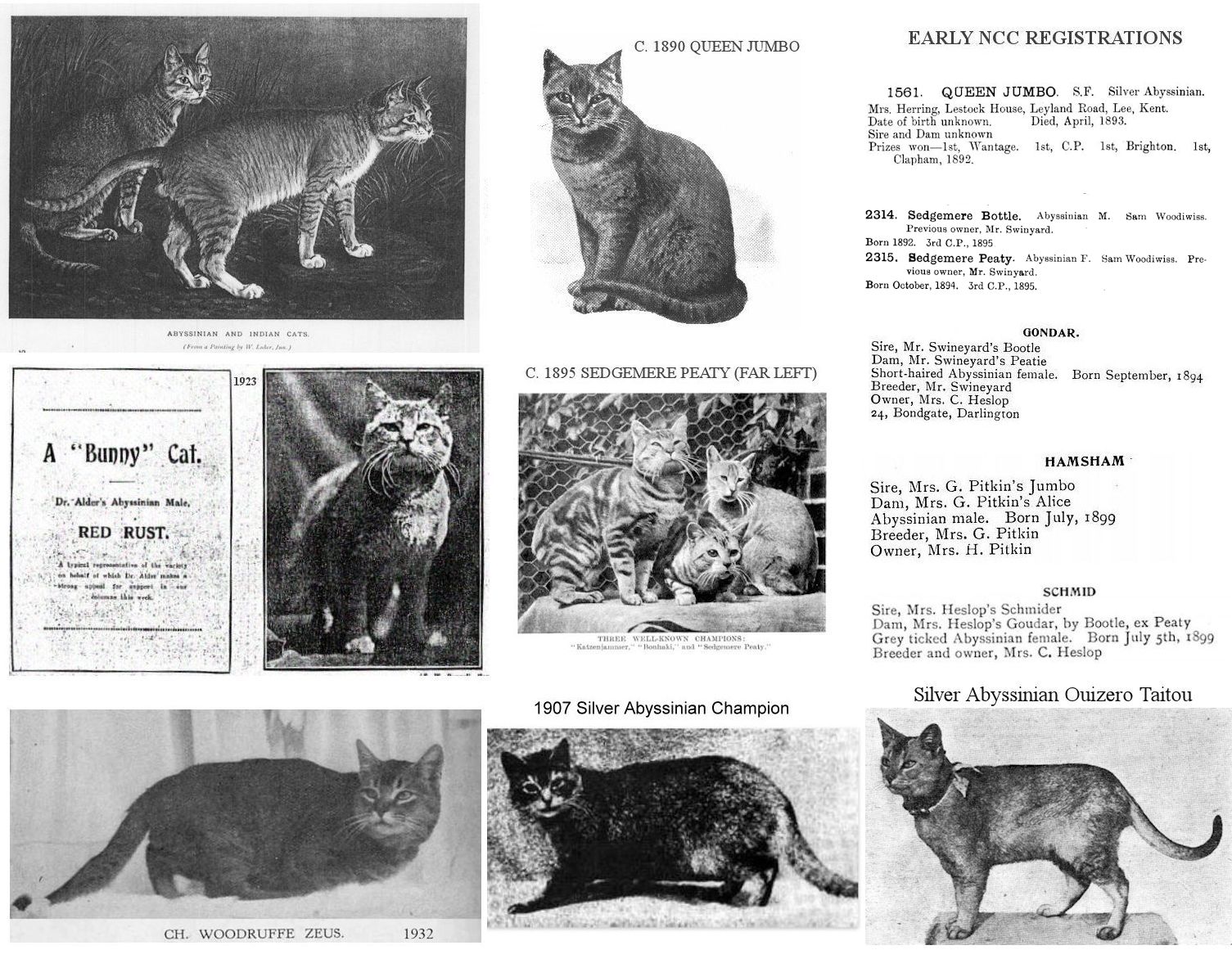
Sedgemere Bottle was born in 1892 and Sedgemere (later Chelsworth) Peaty was born in October 1894. Both were exhibited in 1895. Queen Jumbo was exhibited at three shows in 1892 so she was probably born in or before 1891, making her the first registered Abyssinian. She was also a silver Abyssinian, but her ancestry is unrecorded. The next registered Abyssinian was Gondor of Darlington (NCC 3263, female) owned by Mrs Heslop, bred by Mr Swineyard (who had acquired the two Sedgemere Abyssinians) and born September 1894. She was registered as the daughter of Sedgemere Bottle & Sedgemere Peaty (which must be a birth-date error as Peaty was born in October 1894) and won a First at Crystal palace and 1st CP in 1899. She was probably born in 1895, prior to Peaty being bought by Mr. Sam Woodiwiss. The erratic spelling in the stud books and registers also show her as “Gondar” by Bootle x Peatie and as “Goudar.”
In Vol 1-2 of The Cat Club Register (not stud book) we find Schmid, a “grey-ticked” Abyssinian female born 5th July, 1899. Schmid was sired by Mrs. Heslop's Abyssinian male Schmider and her dam was Goudar [Gondar of Darlington]. Schmid was not listed as silver Abyssinian and was probably genetic blue from early Russian Blue outcrosses. In some databases, Aluminium and his son Platinum of Thorpe are listed as “blue silver” while Fancy Free and Silver Fairy are listed as “black silver.”
Also Listed in Vol 1-2 of the NCC Register (not the stud book) was an Abyssinian female called Alice, parentage unknown, owned by Mrs G. Pitkin [Alice]. She is also listed as the dam of Hamsham, a male Abyssinian born July 1899, sired by Mrs G. Pitkin’s Jumbo. Mrs. Pitkin’s Abyssinians were described by H.C. Brooke as “fair,” being too dark in colour and too much like British Ticks in type.
Ticked cats were exhibited under a variety of names including Algerian, Hare cat or Bunny Cat. The Bunny Cat was distinct from the Abyssinian and Louis Wain described them as very big cats, both shorthaired and longhaired, that were born black and later lightened to an unbarred agouti coat. Around the 1900s, the Abyssinian was also known as the “British Tick” and had heavily barred legs and tail from being extensively crossed with British Shorthairs including those Bunny Cats. Although classed as "foreign cats" they were far removed from modern Abyssinian cats. Longhaired ticked kittens were being born, but these “sports” would not be recognised in their own right until much later.
1900 Mrs [Constance] Carew-Cox began breeding Abys around this time. Mrs Carew-Cox, who is most often associated with Russian Blues, had discovered the breed in a Somerset hotel. She bred both types – ruddy and silver – and some of her silvers were exported to the USA although the colour died out both there and in Britain. It is also likely that some of those silvers were genetically blue rather than black. They were referred to as British Ticked and the “British type” was favoured over the foreign type. Mrs. Carew-Cox also received word from a gentleman who had been shooting in Abyssinia; he had shot two wild cats and their preserved skins corresponded to the Abyssinian breed.
As far back as the 1900s, Silver Abyssinians (both black silver and blue silver) occurred alongside the Usual/Ruddy variety, due to crossing Abyssinian cats with Persians. These were known as Silver Grey Abyssinians, Chinchilla Abyssinians or Albino Abyssinians. British judges didn't like them. Silver Abyssinians - called Aluminium I, Aluminium II and Quicksilver - were bred by Mrs Carew Cox in the early 1900s. She exported them to the USA to found the breed there. By the 1920s, they had died out in the UK as they always lost out to the Usual Abyssinian on the showbench. Silvers didn't catch on in the USA either.
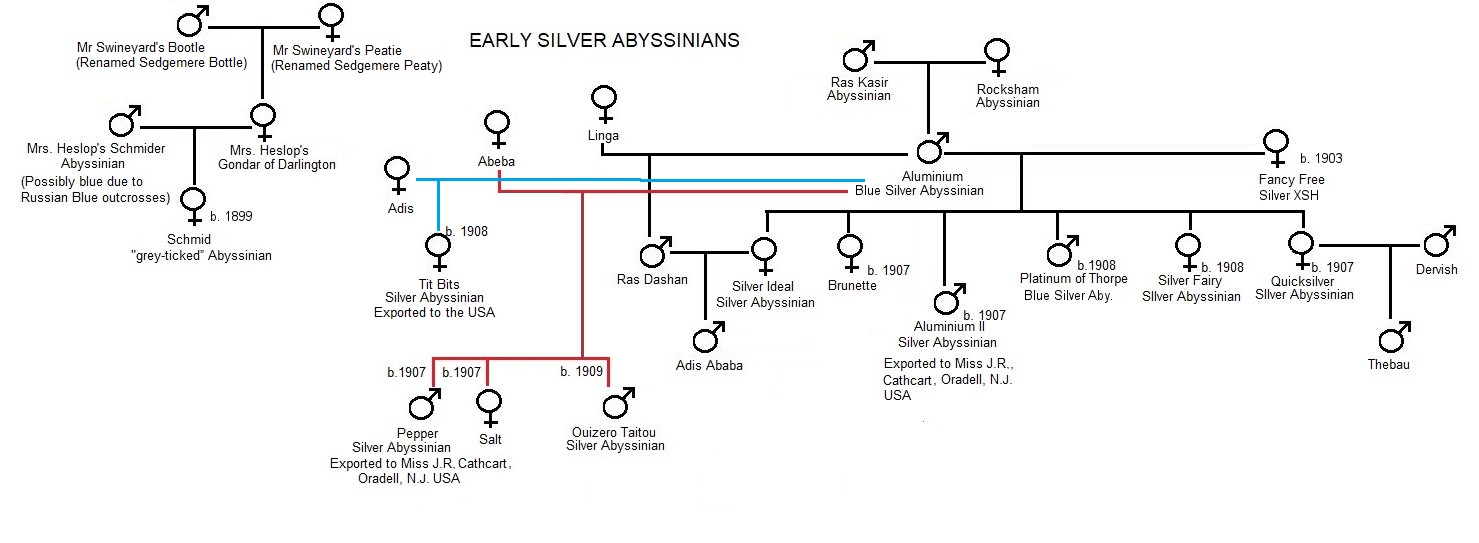
H.C. Brooke was very opposed to Silver Abys them, and in his booklet "The Abyssinian Cat", he wrote, "I regard silver as an absolute alien colour to the breed, and though there would have been no harm done if these silvers had been kept to themselves, I cannot but think that they did an infinity of harm to the breed, by introducing a grey tinge into the coat, with the result that the beautiful "ruddy" tinge which we used to see in the cats of long ago, is now apparently lost to us. How they originated, or whether any cross was made use of to obtain them, I do not know." Nevertheless, the 14th edition of the Encyclopaedia Britannica contained a picture of a beautiful "Silver" Abyssinian belonging to Mrs. Carew-Cox. Upon H.C. Brooke's retirement from the cat fancy, Mrs Carew-Cox who worked hard to keep the Abyssinian from dying out entirely.
Mrs Carew-Cox’s Abyssinian stud Aluminium, who is retrospectively considered a blue silver, (Ras Kasir x Rocksham, a silver aka Shamrock) sired a number of silvers. His registered progeny include the very successful prize-winner Ouizero Taitou (b. 13/09/1909, dam: Abeba). The same Aluminium x Abeba pairing had earlier produced Salt (silver) and Pepper (ruddy) in October 1907. Salt and a half-brother, Aluminium II (Aluminium x Fancy Free, a black silver Aby) were all exported by Mrs Carew-Cox to Miss Jane Cathcart in the United States. Their ACA registration numbers can be found in some of the databases. Aluminium x Fancy Free also produced Platinum of Thorpe, Silver Fairy, Quicksilver and Brunette (ruddy/usual Abyssinian?). Aluminium was also sire of Ras Dashan who was mated to Silver Ideal (Aluminium x Fancy Free). In the GCCF 1912 stud book the only female Abyssinian listed is Mrs E A Clark’s "Silver Fairy", bred by Mrs Carew Cox.
According to a show report in the Hastings and St Leonards Observer, 22nd December 1906, Mrs. C. Cox, exhibited “an imported silver Abyssinian a new and beautiful variety,” which won a first prize, second prize, and two specials at that year’s Crystal Palace Cat Show. A show report published in November 1907 identified the imported silver Abyssinian as “Fancy Free,” (NCC Registration No 4934 and her parentage was unknown) though other sources say Fancy Free (a female born in 1903) was bred by Mrs Cox. “Our Cats,” of 8th May 1909 repeats that she was imported. Fancy Free’s offspring (sired by Aluminium) include Aluminium II, Quicksilver, Silver Fairy and Platinum of Thorpe.
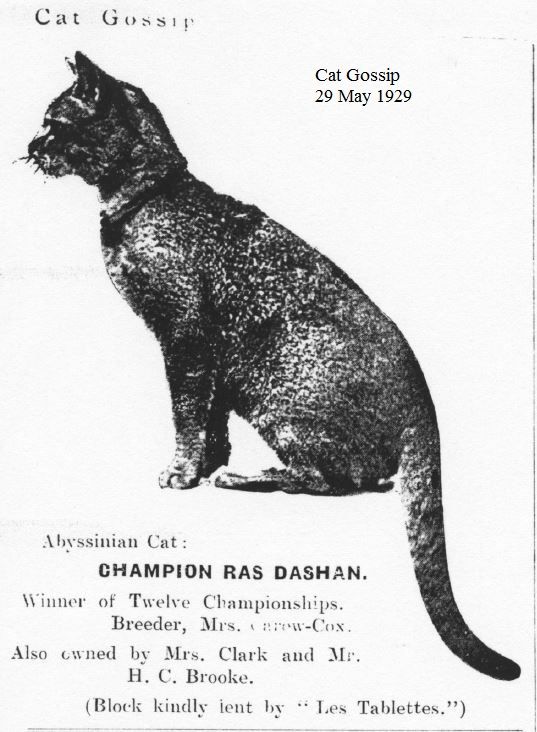
Despite disliking the silver Abyssinians, H.C. Brooke greatly respected Mrs. Carew-Cox who bred a number of silvers. He retired from collecting and breeding cats and credited the survival of the Abyssinian breed to her efforts. In 1903, Brooke wrote of the silver "It is a ticked cat but not the proper Abyssinian colour." Elsewhere, he wrote "I regard silver as an absolute alien colour to the breed, and though there would have been no harm done if these silvers had been kept to themselves, I cannot but think that they did an infinity of harm to the breed, by introducing a grey tinge into the coat, with the result that the beautiful "ruddy" tinge which we used to see in the cats of long ago, is now apparently lost to us. How they originated, or whether any cross was made use of to obtain them, I do not know." Quite likely they’d come from crossing Abyssinians to Chinchilla Persians in an attempt to improve the ticking of the Persian cats. Conversely, a few years later, in 1908, W Johnson Wood commented that "the silver specimens are even nicer than the brown"!
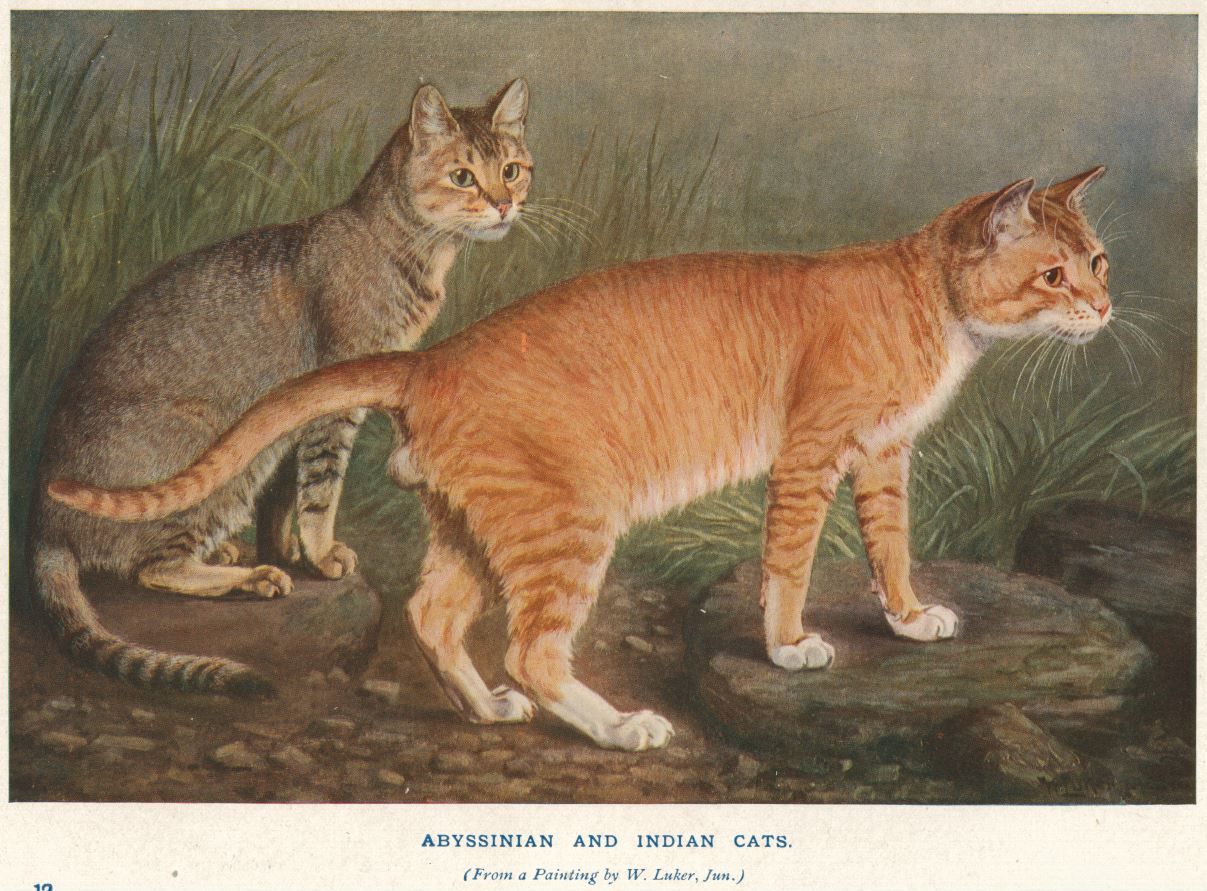
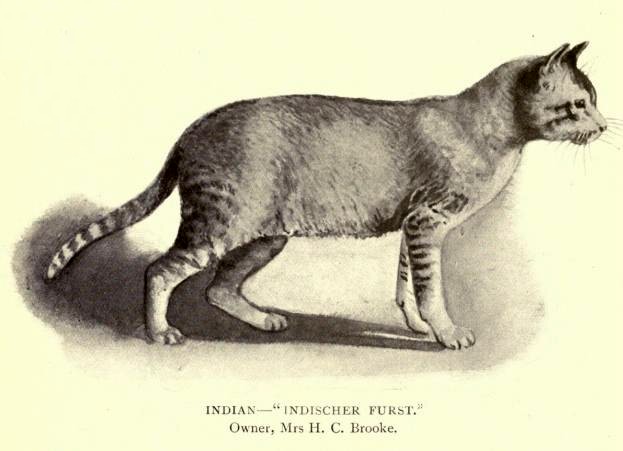
1901 - Mr. H. C. Brooke, a noted fancier and importer of dogs and cats, had imported an “Indian Cat” named Indischer Furst which had a bright red ticked tabby coat. Indischer Furst was exhibited at the Crystal Palace in 1901 and is depicted beside a darker Abyssinian cat in the Book of the Cat. Brooke also imported “Egyptian” or “African” wild cat that also resembles the Abyssinian. Later on, his wife announced that she had four more “Indian Cats,” these were also red and they lacked the white throat and forepaws of Indischer Furst.
Brooke described this cat in Cat Gossip in 1927, “A remarkable Indian Cat: Only a small proportion of present-day exhibitors, we think, will remember the remarkable Indian Red Cat, who created such a sensation on his appearance in 1901. He gave rise to a lot of discussion, and is much of a mystery to the present day, when his skin is, I believe, in the possession of Mr. R. I. Pocock, the former Superintendent of the Zoological Gardens, who is, however, unable to account for him. As a kitten he was one of the most remarkable looking cats we have ever seen. When about four or five months old, his ears looked very large, and, with his very pointed face, gave him almost the appearance of a young fox. His legs were long and slender, his beautiful whip tail would have done credit to a Pointer dog; his coat was extraordinarily short, almost like that of a freshly clipped horse. His colour was a beautiful rich chestnut red, fading into paler tints on the belly, and legs and tail were slightly marked. His forehead was wrinkled like that of a Chow.
He was stolen from an hotel in Bombay, along with another kitten, which died en route. This one fell overboard once, and was rescued with difficulty; on another occasion he got into the coalhole on the boat, and was brought up as black as a crow. Arrived in London, he got on the roof of the house, and perambulated the roofs of the East End tenement wailing like a lost soul. He did a good bit of winning, and caused a great sensation. Like so many Oriental cats, he would walk perfectly in the street on a lead. These were the days of the ring classes,” and we remember his clearance of the ring on one occasion when another tom was rude to him. On one occasion a cat member of his type, but of different colour, was exhibited by the Hon. Mrs. McLaren Morrison; it was thought to be an Indian Desert Cat, which, however, is quite a different species, and not a domestic cat.
We mated him to an Abyssinian queen, and she had a couple of kittens exactly like him, except that they were not so fine in coat. Unhappily they only lived a very short time. Now comes the incident which has made us a believer in Telegony, or the influence of a previous sire. This Abyssinian cat, when we broke up our kennels and cattery in 1904, remained in London, the Indian going to Kent. Some eight months after-wards, the Abyssinian, having mated with some stray, produced, amongst a litter of blacks and tabbies, one beautiful red kitten the image of the former Indian lover. Such a kitten has never been since observed to our knowledge. How [can we] explain this but by Telegony. We are well aware that modern scientists do not recognise Telegony; at the same time the wiser ones preserve an open mind on the question, and we may well here quote Mrs. Veley's words of a few weeks back as regards another matter:- “I think, after fifty years spent in the study of biology, we should not be too cocksure that things cannot happen because they are rare and seem unlikely.” In any case, the extreme sensibility of the cat makes it appear to us to be one of the most probable animals to indulge in some such peculiar behaviour, if at all feasible. A beauti-ful miniature of this cat was painted by the celebrated miniature painter, our old friend, the late Mr. J. W. Bailey, or “Pa” Bailey, as he was affectionately known to dog show frequenters of thirty years ago. At Cruft's Show, in 1902, he passed the case containing this with a number of doggy miniatures around a circle of friends for inspection; carelessly it was allowed to reach the hands of a stranger, and about a hundred guineas’ worth of miniatures disappeared, and were never heard of again!
When in London, the Indian Cat liked to walk on the roofs, making it possible he contributed to the gene pool of local stray cats. When, some eight months after the Indian Cat was sent to Kent [Brooke had a property Welling, Kent] the Abyssinian female mated with a stray cat and produced a red kitten, it is possible that the stray cat was a son of the Indian Cat from the latter’s rooftop forays.
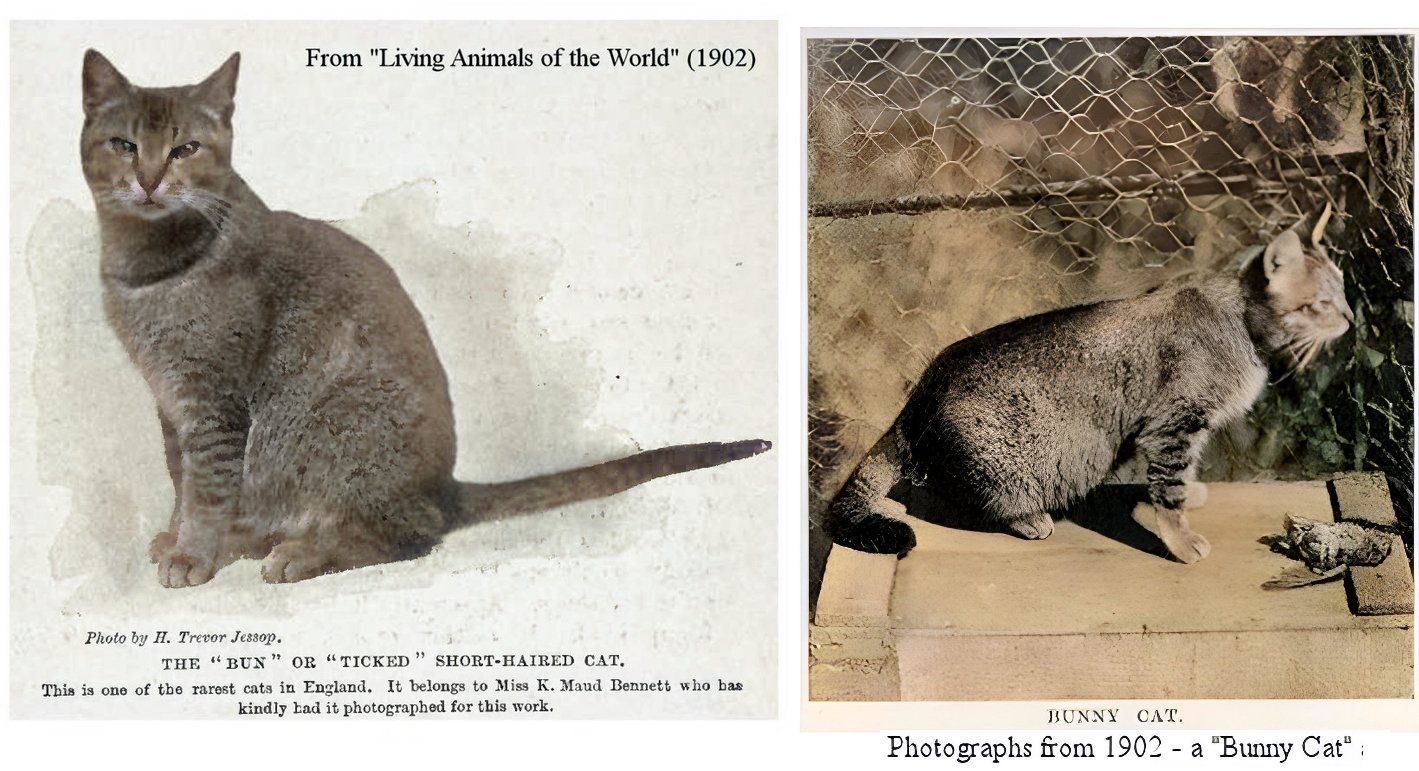
1902 –Early on, the Abyssinian competed against unusual varieties of foreign cats including wildcat species. Those exotic species frequently beat the Abyssinians, although it hard to work out quite how judges discriminated between a domestic Abyssinian (with its standard of points) and an imported wild cat (which had no standard of points). In the "Any Other Variety Foreign Cat" class at the 1902 Crystal Palace show, Mrs Heslop's Abyssinian 'Greek Maiden' was beaten into 2nd place by a Geoffrey's cat. An Indian cat took 3rd place and a Japanese cat took 4th. These unusual cats undoubtedly added to the interest of the show, but Abyssinian breeders and fanciers found it quite unfair that they had to compete against wild animals and novelties.
1903 – Siamese breeder, Mrs. W.R. Temple, also bred Abyssinians. In 1903, she advertised several Abyssinian cats for rehoming. These were Young Menelik and Exhail (males) and two females, Tsana (who was pregnant) and Greek Maiden (acquired about a year earlier from Mrs. Heslop). Greek Maiden had been exhibited at The Crystal Palace show of October 1902, by owner/breeder Mrs. C. Heslop. Her sire and dam were Old Greek and Greek Maid respectively. Greek Maiden x Exhail produced a litter in January 1903; one of the offspring was John Bunyan who became Lady Alexander’s stud cat.
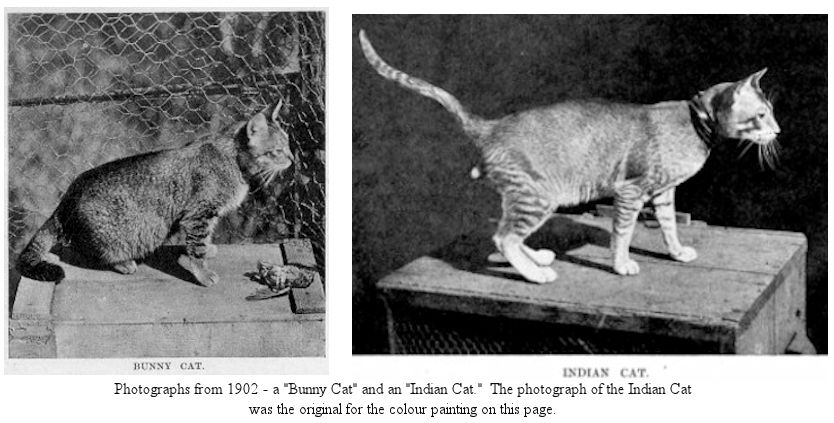
1903 – The Abyssinian breed was featured in a number of publications. In Frances Simpson’s “The Book of the Cat,” (1903), contributor H C Brooke noted a similarity between the Abyssinian and the Caffre cat. Comparisons were drawn between cats depicted in ancient Egyptian art and the Abyssinian cat.
It is not clear how the breed progressed between 1868 and 1903. Even H.C. Brooke, who became an expert on the breed, could not account for 30 years of missing records about the breed. No further cats had been imported from Abyssinia, which meant Zula was bred to British shorthaired cats. Other already established breeds, plus the Indian cats, had been used to refine the early ticked cats into the modern Abyssinian breed. Early Abyssinians would have been mongrels whose ticked, genetically black, coats masked other tabby patterns and colours and which also produced longhaired cats. Silver, dilute (blue), non-agouti (solid colour) and longhair all entered the Abyssinian gene pool.
Louis Wain, editor of "Our Cats" wrote in December 1903 "The Abyssinians, so called, seen in our shows of late years are not the Abyssinians which were exhibited occasionally as a rarity some 15 years ago [1888]. Those cats were a light brown, with just a suspicion of tick on the body, but not one that I have ever seen was free of tabby markings on the legs, head and the ring round the neck. To call the modern ticks Abyssinians is a misnomer. The tick is the ground basis of most tabbies and the pure tick is a conglomerate of Argentine, Chilean, African and in some cases Eastern Cats. I have myself traced the origin of the bunny cats and find them to be of Chilean parentage. They were first introduced to show knowledge by Miss K.M. Bennett, who gave me two kittens, one of which I gave to Mr. Sam Woodiwiss [a noted breeder] who, however, did nothing with it. I have at present four of them, sire and dam, and two eight months old kittens. These have never been shown and I hope to keep them until I can give them to someone who will perpetuate the breed properly and show them. The toms are great cats, far bigger than any cat I have seen at shows for ten years past. The queens are smaller and very highly strung. The tails of all of them are partly ringed and at the stump are as broad as their backs. They are tabby-marked on legs and heads and ringed round the neck. When born, they are nearly black and the first year they are shot with faint thin mackerel markings under the tick marking. The succeeding years the mackerel marking disappears and comes back with age a bit. [...] The fur is bluish near the skin, then half an inch fawn-coloured; following that is a splash of black then the [yellow] tick, and finally tipped with black like a porcupine quill; but please do not call them Abyssinians."
However, "In Living Animals of the World", Wain wrote "The sand-Colour Cat, with a whole-coloured coat like the rabbit, which we know as the Abyssinian or Bunny Cat is a strong African type. On the Gold Coast it comes down from the inland country with its ears all bitten and torn away in its fights with rivals. It has been acclimatised in England." Strangely, Louis Wain wrote in "Living Animals of the World" that "The Manx cat is allied to the Abyssinian" although they did not look at all alike! This contradicts his other comments! Quite what Wain's Chilean cats were is uncertain, but evidently the recipient, an experienced breeder, decided they were not Abyssinian and, wisely, did not breed them.
Wain also urged that classes be thrown open to "All ticks, including all English and foreign varieties and colours [and not] levelled down to a cat which is not an easy breeding one. […] The 'bunnies' [British Ticks] throw both long- and short-haired kittens and many are born dead or killed by the mother; hence the strength of the breed; the ailing kittens are killed off."
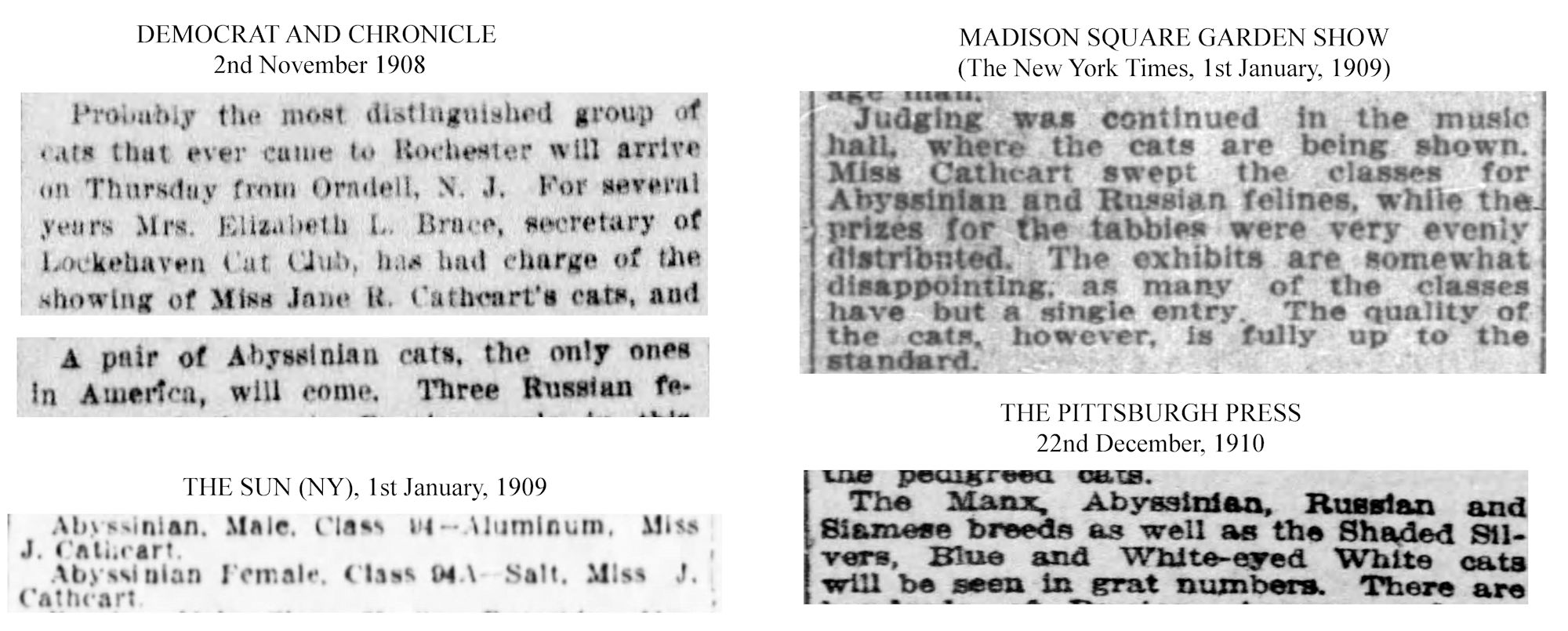
1907 - The first recorded Abyssinian cats in the USA were those owned by Miss Jane R. Cathcart of Oradell, New Jersey. Her cats were exhibited on her behalf by Mrs Elizabeth L. Brace. They were exhibited in Boston, Massachusetts in 1909. These were Champion Aluminum and Salt. CFA records for 1917 tell us that a male Abyssinian called Boz Ah Sin had been born August 1914 (sire: Binnacle Sin, dam: Hell On Ship) and registered by owner Mrs. Owen Kildare. The official premium list of the Boston Cat Club for 1920 show there was a classification for Abyssinians. The Abyssinian would not reappear in the USA until almost 15 years later.
|
Abyssinians Registered in the ACA Studbook and Register No. 3 (1909): ABYSSINIAN—MALE. Imp. Pepper 707. Imp. Aluminium II 709. ABYSSINIAN—FEMALE. Imp. Salt 711. Imp. Brunette 712. |
Abyssinians Registered in the ACA Studbook and Register (1916): SILVER ABYSSINIAN—MALE. Gondar 1288 [7271]. SILVER ABYSSINIAN—FEMALE. Tit Bits 1286 [7268] Abyssinians Registered in the CFA Studbook and Register (1917): 2223. BOZ AH SIN. |
1910s-1920s – Champion Southampton Red Rust, Claude Alexander's exceptional Abyssinian was mated to an "Imported African Wild Cat" and the female offspring, Goldtick 01/04/1923), registered as an Abyssinian. Goldtick was mated to a red self (solid red) called Ras Brouke (owned by Mr HC Brooke in the 1920s) and produced Tim the Harvester (03/04/1930), registered as a Ruddy (Usual) Abyssinian. Tim the Harvester sired Woodrooffe Ras Seyum (born 1935) and other offspring in Britain before going to the USA circa 1938 and established some of the early British lines of Abyssinian. Ras Brouk may have introduced sorrel red and cinnamon into Abyssinian lines, but has also been described as chocolate in colour. Woodrooffe Leo, born in 1933, was other self red, but was unrelated to Ras Brouk. Another red Abyssinian, Nona's Red Chiki, born 1943, was related to both Ras Brouk and Woodrooffe Leo, while her maternal grandmother was a seal point Siamese called Miss Melodious Venture! With outcrosses to other breeds and to imported wild cats, no wonder "sports" appeared in later generations.
In those early days, Abyssinians with no ticking also appeared, though most would have been discarded. Some, presumably having excellent conformation, were used in breeding programmes. In the 1930s, a "self black" Abyssinian called Woodroofe Nigra was registered. Nigra's parents Ras Isis and Empress Zauditu, were both Abyssinians and would have carried the gene for solid (non-ticked) colour. Nigra's grandson, Croham Menelik, became an influential sire.

1920s – A strain of blue-eyed “albinistic” Abyssinians had been bred by Sir William Cooke, of Newbury, but in 1927, his last male died, thus ending a very remarkable strain of albinistic Abyssinians. HC Brooke noted that a lady in Yorkshire owned a pair, but had never shown them and that she was contemplating having the male neutered. It was suggested that the strain derived from a cross with Siamese cat, but Sir William was confident that this was not the case and that the colouration did not bear out this theory. These cats were creamy white, with rabbit-coloured fur on their ears and an "eelstripe" or dorsal line down the back. Their eyes were blue suggesting a form of albinism.
1920s – Up until World War I, British Abyssinians were bred and shown in a range of colours: usual (ruddy), silver, red (sorrel/cinnamon), chocolate, grey (blue) and fawn, but by 1929 only the Usual/Ruddy was exhibited because these found greatest favour with the judges. In France, in 1927, there is documented existence of an Abyssinian Cat named "Ras Tafari" (reference: "Les plus beaux chats de France", Gisèle Barney). It was reported from Vienna by Herr Lesti that Ras Tafari’s second litter contained one kitten that was fawn with a pinkish tint, although all of Ras Tafari’s other offspring resembled their sire.
1928: Brooke exhibits a solid red cat known by line-chasers as "Brooke's Self Red" (aka Ras Brouk?), though this can’t have been an Abyssinian because it was solid in colour, totally unmarked and had red whiskers. This indicates a non-agouti cat, and non-agouti cats did turn up in early Abyssinian lines. It had no vestige of tabby marking, even on legs and head, which would have been exceptional for an Aby in the 1920s and while it suggests homozygous ticked tabby, the photo and descriptions indicate a non-agouti cat because it is evenly coloured. The "fading to straw colour" at moulting time makes me think of "rusting" but diluted. Ras Brouk was mated to Claude Alexander's Goldtick, producing the influential sire Tim the Harvester, a Usual (Ruddy) Abyssinian who is behind sorrel and cinnamon lines. (Brooke’s Indian Cat (1901) and the self-red (Ras Brouk, 1920s), both of whom are claimed as the source of cinnamon by line-chasers, are not the same cat. )
1929 –The Abyssinian Cat Club was founded by Sam Woodiwiss and his father, Major E S Woodiwiss (Sydney). It would probably not have become a true breed without the efforts of this club whose principal object was “The promotion of the pure breeding of the Abyssinian Cat”. Breed is recognised by the GCCF.
1930 – H.C. Brooke wrote in his booklet, “The Abyssinian Cat” - "The general appearance of the Abyssinian is that of a rather small and very elegantly built cat, with graceful slender limbs, fine head with rather large ears and lustrous eyes. Any person capable of appreciating truly graceful lines and sinuous and elegant shape in the cat, will admit that in this respect the Abyssinian cat has but one rival, to wit, the Siamese." He wrote elsewhere in 1930: “It is with genuine regret that I have to state that it has been impossible to discover any really satisfactory facts regarding the history of this beautiful and interesting breed.”
H.C. Brooke also wrote "About thirty years ago some very good Abyssinians were shown by the late Mr. Heslop, of Darlington; Mrs. Alice Pitkin also exhibited some fair specimens, many of hers, however, being too dark and ‘British Ticks’ in type. Later Mrs. Clark, of Bath, possessed many excellent specimens. I bred quite a number at that period, perhaps the best being 'Chelsworth Peaty', who greatly interested Queen Alexandra, then Princess of Wales, when I exhibited her, suckling a ferret, at a Botanic Gardens Show. I sent quite a number to Continental menageries and fanciers; early in the century, however, I gave up all dog and cat breeding, and left London for the West Country to devote myself entirely to hunting. Had not Mrs. Carew-Cox about this time devoted herself to the breed I very much fear it would, ere now, have become extinct. Neglected - Heaven knows why - by the Fancy at large in an inconceivable manner, this beautiful and interesting breed certainly owes its existence to-day mainly to the devoted care and affection bestowed upon it by Mrs. Carew-Cox, who for a quarter-of-a-century has fostered it in the face of discouragements which I verily believe would have ‘choked off’ any other person in the Fancy. Not for her the ‘big business’ in stud fees, the ‘queued-up’ queens, the cups and specials galore, which fall to the lot of many Long-hair breeders; no, in the face of rotten judging, lack of recognition, poor prizes, lack of market, and a heart-breaking mortality in kittens, this plucky lady has carried the Abyssinian flag triumphantly through. She cannot (or modestly will not?) tell me how many champions she has bred since some thirty odd years ago she fell in love with the first specimen she saw at an hotel at Winscombe, Somerset, where they were said to have been left by one who had been a traveller in ‘furrin parts’. Incidentally, I may mention that a good many years back Mrs. Carew-Cox published a couple of letters from a gentleman who had been shooting in Abyssinia, and who stated that he had there shot a pair of wild cats, whose skins he brought to England, and which seemed from the description to correspond in every way with our present-day exhibition specimens."
Brooke died in November 1930, having been taken ill when travelling to the Croydon Cat Show.
1931 First all-Abyssinian Cat Show (UK)
1934 – There appear to be no records of Abyssinians bred or registered in the USA after 1917. In 1934, Mrs. Gardiner Fiske of Boston imported a pair of kittens from England: Woodrooffe Anthony and Woodrooffe Ena, bred by Major Sydney Woodiwiss. They produced three litters for Mrs. Fiske's, but only two survived kittenhood. Anthony was later neutered and kept as a pet by Mrs. Fiske. Ena was acquired by Mrs. Arthur Cobb of Newton, Mass and became Woodrooffe Ena of Newton. The first recorded Abyssinian kitten in the USA was Addis Ababa (b 7/7/1935, female) but she died young, as did her 2 male littermates. In 1936 Mrs. Martin Metcalf and Miss Mary Hantzmon of Washington, D.C., saw Woodrooffe Ena at the cat show at Danbury, Conn., and persuaded Mrs. Cobb to lease her to them for breeding. Champion Ras Seyum was imported from England in 1937 as a mate. Raw Seyum was considered the best Abyssinian in Great Britain and Major Woodiwiss was criticised for exporting him. Ras Seyum’s photo appeared in National Geographic Magazine in November 1938. From then on, several more were imported and the breed took off in the USA.
1936 – Longhaired Abyssinians Documented But Not Bred.
1937 – In Holland, Abyssinian cat history began 1937 with an imported British ruddy (usual) Abyssinian called Selesdune Buntibou who bore a litter sired by Woodrooffe Zeus, however that breeding line died out during the Second World War.
1938 – An article written by breeder Mrs. H.W. Basnett and published in a 1938 edition of "Fur, Feather, Rabbits and Rabbit Keeping", gave the standard for the British Abyssinian: "The typical Abyssinian has a long, lithe body, showing well-developed muscular strength, and the beauty of the long, fine head is accentuated by luminous, almond-shaped eyes. The whole head is set off by large ears, broad at the base, which, while matching the feet and legs in colour, are tipped with a darker shade. The coat is short and close-lying, of a rich, tawny brown colour, and instead of being striped or barred, each hair is 'ticked' with black or brown, i.e., two or three bands of colour on each hair being preferable to a single ticking'. The feet and legs must be clean colour, free of barring and toning with the body colour, whilst the under parts of the body should preferably be an orange-brown to harmonize with the main colour."
1940 – The Abyssinian Cat Club was disbanded because of the war. Everyday business was left in the hands of Miss Adams and Major Woodiwiss.

1947 - The Abyssinian Cat Club resumed without Miss Adams or Major Woodiwiss (they died during the war). Barely a dozen Abyssinian cats survived after the war. Those instrumental in re-establishing the breed included Mr & Mrs Denham, Mrs Basnett, Mrs Earnshaw, Lady Barnard, Mrs Winsor, Mrs Oswald, Lady Liverpool, Mrs Simmonds, Miss Bone, Miss Wilson, Miss Wiseman and Mrs Menezes. From there on, the Abyssinian is well-documented. Initially it was only recognised in the ruddy (usual) colour, the silver variety having lost out on the show bench. Over the next few decades, other colours (inherited from outcrosses early on) would be recognised as would the semi-longhair version dubbed the Somali.
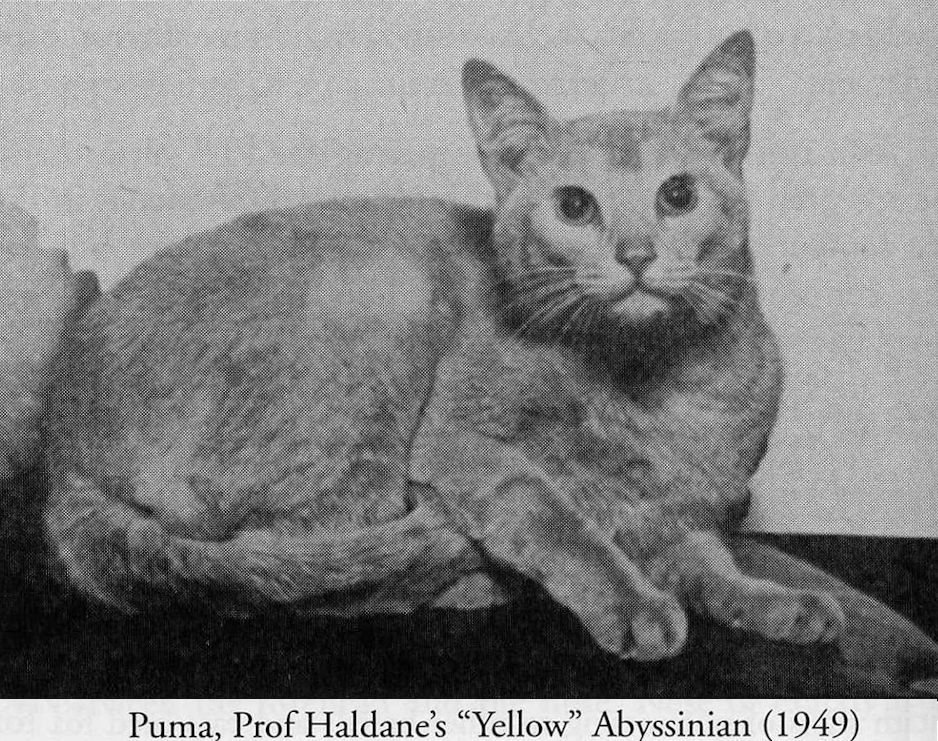
1955 - 2 more non-ticked (solid black) Abyssinians were born. Mrs Windsor’s Merkland Negus (born March 1949). Bred to Miss Bagshaw’s Merkland Sallie, he sired a self-black called Simmie and 2 usual/ruddy kittens (born 14th October, 1955). He had previously sired a self-black kitten when mated to a queen belonging to Mrs Menezes.
1957 –In the 1960s, Mr. and Mrs. William Maguire of South Weymouth, Massachusetts owned a cat from Abyssinia that met the criteria for the Abyssinian breed. Named "Smokey P", he was born in Addis Ababa, Ethiopia in 1957 in the home of an American family there. His mother was a native domestic cat and his father was a ticked semi-wild cat. He was eventually exported to the USA when his owners moved back home.
1960s –Longhaired kittens had appeared in Abyssinian litters back in the early 1900s, but had been disregarded as undesirable by breeders. It was common practice to destroy “sports” that did not meet the standard. The loss of many breed lines during World War II led to another wave of cross-breeding that may have reintroduced the longhaired gene into the Abyssinian breed and caused it to become more widespread. Rather than destroy the non-conforming kittens, breeders quietly homed them as pets. Breeders eventually realised that the longhaired cats were attractive in their own right. In 1965, a longhaired Abyssinian was exhibited in Australia. During the late 1960s, longhaired versions of the Abyssinian started to be deliberately bred in the USA and Canada. The name Somali was chosen to reflect its relationship to the Abyssinian rather than any geographical origin. Somalis were recognized in the USA in the late 1970s, and European recognition followed some time later.

1966/7 – Silver was reintroduced when a Usual/Ruddy Abyssinian (Lalibela Jijiga) was bred to a Silver Spotted British Shorthair (Culverden Mercury). This colour had been present from the 1880s, but had died out in the 1920s.
1972 – The 1972 CFA Yearbook had a photograph of a yellow Abyssinian called Puma and mentioned that "Albino" (silver) Abyssinians existed in England as well as creams and blues (familiar in England, but not in the USA).
In Abyssinians, the four basic ticked tabby colors are: the black-based colour is known as ruddy, tawny, or usual; the sorrel or cinnamon color also known as non-sex-linked red; blue; and fawn. Other colours include chocolate and lilac ticked tabby. Early cat literature and illustrations refer to the ruddy colour cats as Abyssinians, while the red or sandy version (cinnamon) was called the Indian cat. The blue and fawn colors were developed in England through early outcrossing to Siamese and Russian Blues. Sex-linked red, cream and torties are also recognized by some registries. Any of those colours can occur as silver ticked tabbies. In silver series Abyssinians, the lighter banding of the hair shaft is pure white. The colour and ticking of an Abyssinian or Somali becomes more vivid with age.
EARLY SOMALIS
In 1977, Patricia Warren wrote about the origins of the Somali, and long-haired Abyssinians in championship lines in North America, in Cat World (International). In 1967, a long-haired Abyssinian cat was taken to a shelter in New Jersey where an Abyssinian breeder, Evelyn Mague, noticed it and looked into its pedigree. Finding the cat (named George) to be a son of her stud cat Lynn-Lee's Lord Dublin and a female called Lo-Mi-R's Trill-by (which she had just bought) she knew that her cats carried the longhair gene. George had been rehomed as a neuter, but she confirmed that her cats were longhair carriers by breeding 5 more longhaired Abyssinians from them. (Jumping ahead a decade, one prizewinning Somali brings the story right back to George. His full brother, Lynn-Lee's Christopher, bred by Mrs Mague, won high honours at a CFA show in Jackson, Mississippi in 1976.)
Meanwhile in Canada, the longhair gene turned up in May-Ling Tutseita owned by Ken McGill. When mated to one of his own daughters, longhaired kittens resulted. Evelyn Mague's research found that longhaired Abyssinians had occurred in the mid-1950s and were either destroyed or sold as pets, while the parents were neutered to prevent the spread of the gene. In eliminating the gene, breeders were also eliminating the pushiness of the Abyssinian coat, something particularly found in cats carrying the longhair gene. Mague named the longhaired cats "Somali." By the early 1970s, Somalis had been reported in lines such as Du-Ro-Al, Saika Shams, Saffron, and Toujour Lapinchat. Their pedigrees pointed to Somalis having a common root.
Some Abyssinian breeders insisted the Somali was a hybrid. Despite a lack of any evidence, they insisted that North American breeders mush have introduced Persians into their lines to preserve the increasingly rare plushy coat, and had covered this up with false pedigrees. As a result, they claimed, the Somali would not breed true for colour. In fact, Somalis were no more likely to produce blues or silvers than their Abyssinian kin. The CFA were concerned that "shorthaired Somalis" would be registered as Abyssinians, overlooking the fact that Abyssinians heterozygous for longhair had been unknowingly registered for years as they had the best coat type. There was still breeder prejudice against the longhaired variants.
Walter Del Pellegrino, from New York, researched the Somali's origins and found that all the registered Somalis traced back to May-Ling Tutseita, or to four Abyssinian stud cats in the 1960s: Chota-Li's R.S.T., Sheramain's Dabtu, Dalai Robin of Mehitabel, and Ring's Abi Abdel of Selene. All five of these cats traced back through May-Ling, Shermax, Selene and other early Abyssinian lines to a single Abyssinian imported from England by Mrs Schuler-Taft (Selene prefix) in 1952 - Raby Chuffa. Raby Chuffa was also the source of sorrel (non-sex-linked "red") in Abyssinians.
It was not possible that North American breeders had crossed Abyssinian to Persian because there were not enough generations to restore the correct Abyssinian type and markings. Nor were there any "strange coloured" kittens being born that would indicate recent Persian ancestry. It was possible that some longhaired Abyssinians - registered as Abyssinian, but never exhibited - had been used in breeding to maintain the plushy coat of the Abyssinian. Back in 1972, Rosamunde Peltz had written an article "The Abyssinian cat" for the CFA Yearbook in which she said "The appearance of longhaired Abyssinians should not be, and was not, a surprise to knowledgeable breeders."
In England, after World War II, many breeds were down to only a few remaining purebred individuals. The war had almost extinguished the cat fancy and many of the finest show animals were killed or had become strays during the bombing raids. In post war England there may have been as few as a dozen Abyssinians left. To keep a line going, breeders had to use cats of unknown parentage, some of which probably carried the longhair gene. Another possible source of the longhair gene was the native "Bunny Cat" in Britain (once a distinct variety: large, shorthaired and longhaired, born black and lightening to an unmarked agouti coat according to Louis Wain) or early experiments with Angoras and Chinchilla Persians that resulted in Silver Abyssinians. If early breeders were selecting for the plushy coat then the longhair gene might have stayed in the gene pool and any longhaired offspring were kept secret.
Pellegrino narrowed the longhair carriers down to the cats behind Raby Chuffa. Because studbooks were incomplete (listing only show-winners) or pedigrees were being recorded on spare paper and even in the fly-leaves of books (such as a Siamese pedigree I have), or were lost in the devastation, he could only come up with an incomplete pedigree. I've drawn up a family tree of the cats
None of Raby Ashanto's other descendants in North America had produced longhairs, which ruled out that part of the pedigree. The gene must have come from Raby Tosca whose mother, Roverdale Tara, was born in 1947, just after the war. Tara's mother, Roverdale Purrkins must have been born during wartime, but Pellegrino could not find any pedigree for her. Of the 26 offspring sired by Raby Chuffa, the CFA only recorded 6 as having produced kittens, and 5 out of that 6 were behind May-Ling Tutseita, Chota-Li's R.S.T., Sheramain's Dabtu, Dalai Robin of Mehitabel, and/or Ring's Abi Abdel of Selene. Another 20 kittens sired by Raby Chuffa had no recorded offspring - four-fifths of his progeny left no trace. Any offspring they had were not registered - either sold as pets or not considered breeding quality Abyssinians.
Raby Chuffa's sire/maternal grandsire was Raby Ashanto who had sired several other Abyssinians that had not produced longhairs further down the line. On the other side of the pedigree, Roverdale Purrkins was born after WW2.
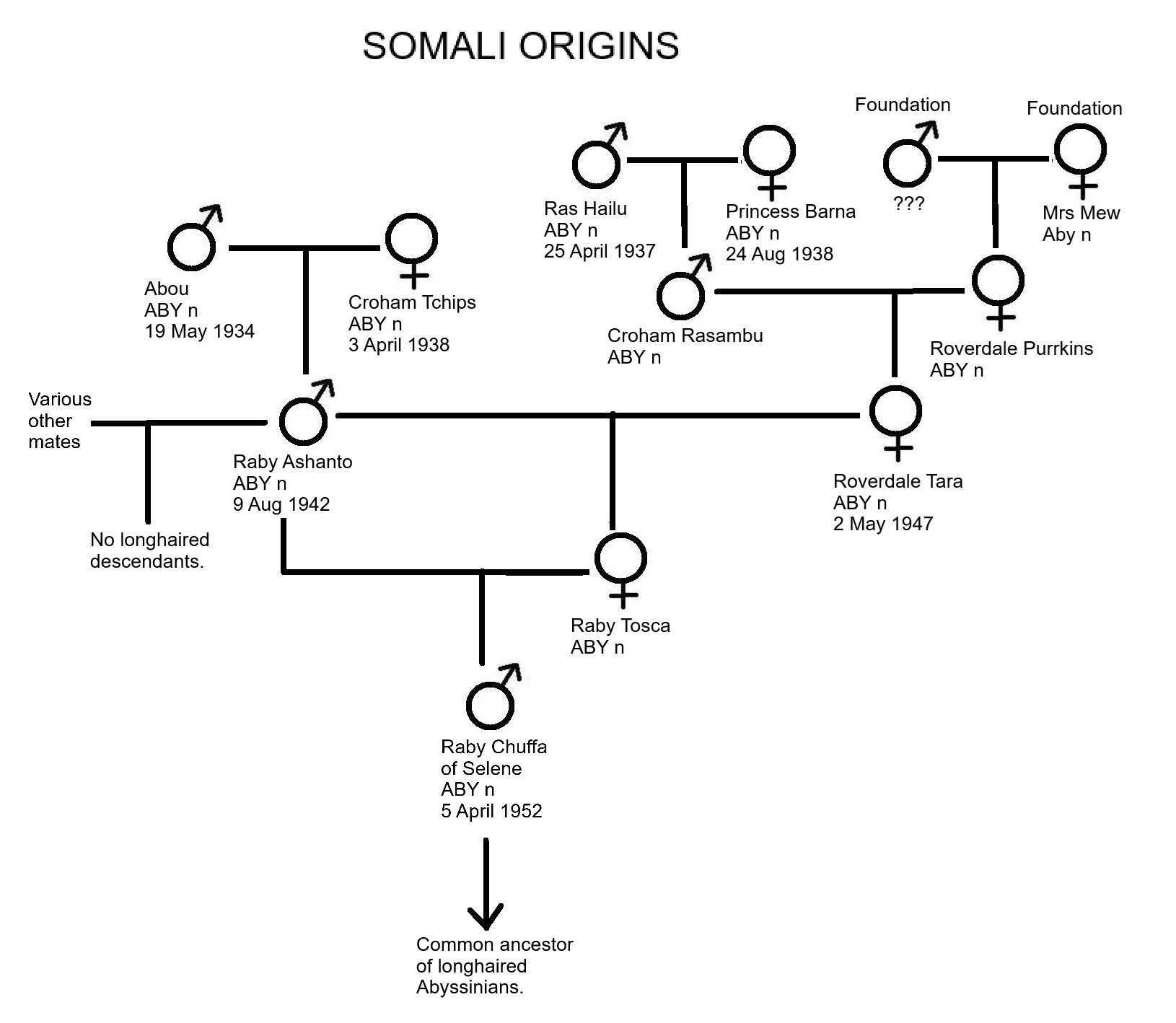
Janet C. Robertson had bred the Roverdale cats. Purrkins' grandmother had reached England with a sailor during World War II and had kittens by an unknown tomcat. One of the female kittens was given to Mrs. Robertson's friend who then gave the kitten to Mrs. Robertson around 1942. Mrs. Robertson recognised the kitten as an Abyssinian, which she named Mrs. Mew. Mrs. Mew produced kittens by an unknown male, including a black kitten (so Mrs. Mew had the non-agouti gene) and the other kitten was Purrkins, who looked just like Mrs. Mew. Mrs. Mew died in 1944. In 1945, Mrs. Robertson set up the Roverdale cattery. Roverdale Purrkins was sent to mate with an Abyssinian male, Croham Rasambu, and produced Roverdale Tara. Tara was mated to Lady Barnard's Raby Ashanto and produced Raby Tosca, the mother of Raby Chuffa. Robertson did no backcrossing or inbreeding of her cats so any longhair gene did not come to light at the time.
Another of Purrkins' kittens was Roverdale Rainier and he became Mrs. Robertson's stud cat. He was mated to Brunswycke Chere, a ruddy female from Mrs. V. Major, and sired the first red (cinnamon) Abyssinians she had ever seen: Roverdale Tawny and Roverdale Martin. Because judges discouraged the red colour neither were bred and this early red line died out. The other Roverdale cats were successful at British shows. Mrs. Robertson retired from breeding and showing in 1950. Purrkins died in 1956. The black littermate proved that Mrs. Mew was a hybrid. There were 8 generations between Roverdale Purrkins and May-Ling Tutseita of Dundedin - in those days "recessives were forever."
It's possible to take the lineage back to the 1930s. In the background of Croham Rasambu is Ras Brouck ("Brooke's Self Red") who may be the origin of the recessive non-sex-linked red gene and who was behind most Abysinians in the USA. Ras Brouck was used to improve the colour of ruddy Abyssinians. Raby Chuffa also sired red offspring in the USA. Once again showing that recessives were forever, a 10th generation descendent of Raby Chuffa, Lynn-Lee's Catfish (b. 1974) sired red kittens.
Two of the earliest Somalis imported from the USA into Britain were Khay, Bella, Black Iron Vagabond and Black Iron Venus in 1980/81 and their arrival led to some linechasing. The owner of Vagabond and Venus's sire, Foxtail's Tawny of Roverdale, was Mrs Janet Robertson, of the Roverdale prefix. Many years earlier, Janet Roberton had lived in London and had bred a foundation Abyssinian, Roverdale Purrkins (female) from an unregistered Abyssinian female called Mrs Mew and an unknown sire. Purrkins' litter mate was a black kitten. Some American fanciers suggest that Purrkins was responsible for introducing longhair gene into one Abyssinian line, and it is interesting to note that her great grandson, Ch Raby Chuffa of Selene - a known longhair carrier - was exported to the USA. Purrkins appears some ten generations back in both Khay's and Bella's pedigrees, and some 15 generations back in the pedigrees of Vagabond and Venus.
Following an article in Fur & Feather, December 1980, more information of early Abyssinian "longhair sports" was uncovered. Six Red (Sorrel) Abyssinian kittens were exhibited at the Kensington Kitten & Neuter show in May 1971, two of which were longhaired variants. They were bred by Mrs McLaughlin but were all neutered and sold as pets. Their sire was Kernow Raver and dam Firefly Olga. Investigation of their pedigree revealed that Tranby Red Tutankhamen was Raver's grandsire, and Olga's sire. Another litter containing Longhair kittens was born in June 1970, bred by a Miss Lucas. The sire was Tranby Red Xanthos and the dam was Kernow Iocasta. There were three Longhairs (a Usual female, a Red (Sorrel) male and a Red (Sorrel) female) plus a single Abyssinian. Once again, Tranby Red Tutankhamen appeared in the pedigree - he was the sire of Kernow Iocasta.
It seems that Tranby Red Xanthos and Tranby Red Tutankhamen (full brothers, but not from the same litter, from Taishun Kephra x Tranby Tephni) both carried the Longhair gene.
OTHER TICKED BREEDS
Ticked cats occur naturally around the world and the term "Abyssinian" is sometimes misused to mean any cat with the ticked pattern, regardless of pedigree. In the 1990s, cats resembling early Abyssinians were documented in Singapore; they were larger and more heavily marked than the pedigree breed. These "Wild Abyssinians" did not meet with the approval of purist Abyssinian breeders in the USA and died out in the USA. The Abyssinian is also one of the parent breeds of the Singapura, now known to have been developed from Abyssinian x Burmese cats.
The Suqutranese (aka Socotranese) was a white Somali-type cat with glistening ticking created by crossing Somalis to white shorthairs to replicate cats that occurred naturally on the island of Socotra. They were developed in England in the 1990s, but did not find favour with the cat fancy. Somali breeders even placed notices in cat magazines denouncing “White Somalis” even though that was never the breed’s name!
For a while, the name Alaskan Snow Cat was given to a variety developed from crossing Somalis to Persians, producing a cat resembling a chunkier version of a Silver Somali.
The ticked pattern is also being reintroduced to British Shorthairs.